Lawrence Cooper, Dan Murphy
June 11, 2020
Lawrence Cooper, Dan Murphy
June 11, 2020

Authors: Larry Cooper & Dan Murphy, AdaptiveOrg
“Who says elephants can’t dance”

Larry Cooper and Dan Murphy provide an introduction to elephant dancing in this eBook on Agile Strategy. By applying agile thinking, organisations transform their strategic planning process from top-down plan-driven to a collaborative process of co-creation. Simultaneously, by intently focusing on the customer, organisations are able to take purposeful action toward a different future.
Agile Strategy is a strategic discovery process designed to ensure the long term viability of organizations through adaptability. It allows strategy, at both the customer and business levels, to emerge from the fog of uncertainty. This becomes extremely important as we grapple with the new reality where there are far more “unknown-unknowns” than “known-knowns” that have to be detected, understood, and addressed.
Agile Strategy starts with “good enough”. Kicking off in only a few weeks, at a fraction of the cost and effort of traditional methods, and based on an opportunity-driven approach. This enables your organization to quickly establish an initial strategy and then, by executing on it, use the gathered evidence and insights to quickly pivot the strategy as needed.
This eBook also introduces us to two new roles for business leaders; that of Culture Curator and Context Curator. Culture Curator focuses on inculcating strong values and principles over proscriptive rules. While the Context Curator ensures everyone (including their customers, employees, and partners) are part of co-designing and co-creating a different future - one where they can collectively survive and thrive through uncertainty.
As Larry, Dan and others have shown, with very large organizations, even elephants can dance.
Evan Leybourn,
Co-Founder & CEO, Business Agility Institute
At odd and unpredictable times, we cling in fright to the past.” – Isaac Asimov
What makes an organization successful? The answer largely depends on the circumstances within which it operates. When those circumstances evolve, so must the organization: What worked in the past may not work in the future. Organizations that successfully adapt to each new “normal” dominate, while those that fail to do so disappear.
For many years, organizations have faced an accelerating rate of change. In recent times, this rate of change has sped up to the point that thriving within a current set of circumstances is no longer enough. Rather, organizations must be able to succeed within a state of unpredictability. Being able to handle sudden or unexpected change is now even more important than being well adapted to any particular moment or circumstance.
To achieve this, organizations must make adaptability, or agility, one of their core competencies. Agile strategy is a proven way to do just that. This e-book will show you how.
Most organizations are not structured for change. Top-down, command-and-control structures with organizational silos make it difficult to communicate across the organization. They operate within slow and bureaucratic stage-gate processes that filter information up to the executive level in order for the executives to make decisions and issue top-down orders. As information is filtered going up the decision-tree, valuable nuances are lost in the voice of the consumer, often replaced by internal objectives and targets that distract from the value proposition.
Governance is rules-based, and plan-driven: workers follow the plan, most often without understanding the intended outcomes. Leaders believe they can manage performance through oversight, but more oversight requires more rules (compliance requirements), adding more constraints and further hampering the organization’s ability to move fast and adapt. Likewise, leaders manage risks through even more oversight and analysis, again crippling organizational agility.
Being oversight-driven means undertaking projects with defined start and end dates, along with set budgets and scope. This serves to further illustrate the inadequacy of traditional thinking to address unprecedented and uncontrollable change. Change has always been a continuum, not an end-state to be reached. All we are witnessing now is the accelerating rate of change, which requires organizations to understand new circumstances and adjust or pivot faster. Agility was always a desirable business capability, but rapid and sudden change exposes how critical it is to organizational survival.
The existential question organizations must now confront is what kind of organization they need to become to remain sustainable (and resilient) over the long run, regardless of the day to day changes they must accommodate.
Becoming more adaptive and agile as an organization first requires its people individually to become more adaptive and agile, a transformation that must begin with the leadership.
The alternative to rules-driven and oversight-based governance is insight-based governance – leadership founded on values and principles. Leading through values and principles is a key mechanism to distribute both leadership and decision-making to the edge of the organization – the point closest to value delivery. This is where those who are best positioned to understand what’s needed to create value can act the fastest on the evidence presented.
According to American professors Jacqueline and Milton Mayfield, leaders who successfully guide their people through change do three key things:
The table below highlights some of the differences between the behavior of traditional organizations and those that are adaptive and agile.
| Traditional Organizations | Adaptive and Agile Organizations |
|---|---|
| Project-driven: defined start and end dates, along with set budgets and scope | Customer impacts and business outcomes-focused: schedule and budget flexibility |
| Stage gates: beginning and end, single pass | Iterative and incremental, ongoing |
| Follow the plan without question | Strategic discovery; question everything |
| Plans are assumptive and mitigated via risk management; all risk is pushed to the end, often after contractual commitments | Planning is emergent and focused on quickly validating assumptions to reduce risk, to deliver customer and business value early and often |
| Leaders make decisions and manage workers | Leaders co-create an environment to enable the full potential of their people to emerge |
| Leaders are accountable but not responsible for delivery and expect workers to follow the prescribed process and rules | Leaders create a shared understanding of the organizational purpose (shared context) and lead from values and principles, enabling people to bring their whole selves to work |
| Leaders communicate goals, objectives, strategy and mission, and hold teams accountable | Leaders co-create a set of shared values and principles that guide the actions and behavior of all, which they model through their own behavior |
| Leaders hold teams accountable for adherence to assumptive long-term plans | Leaders clear organizational constraints so their teams can deliver on customer impacts and business outcomes, letting teams determine how to do that |
| Plan and outputs-driven, even if outcomes aren’t achieved | Focus on customer impacts and business outcomes sets the stage for what to do, enabling adjustments and pivots as appropriate |
| Decision-making is centralized and at the top | Decision-making is distributed to those closest to the information necessary to make good decisions |
| The organization is siloed, communication and collaboration across silos is limited | Teams are integrated and collaborative in the creation of the shared context necessary to achieve desired customer impacts and business outcomes |
This kind of situational behavioral change by leaders illustrates that:
To foster adaptability and agility as more permanent traits of their organizations, leaders need to move away from their old behaviors and move towards two new roles instead:
Traditional leadership relies on the omnipotence of the leader to set strategy and guide the organization. Yet, as we’ve witnessed, organizations that are rules-driven and rely on oversight-based governance cannot cope with massive change. The vanguard companies that have demonstrated they can handle massive change are values and principles-driven, and use insight-based governance.
Our values and principles are what underscore our belief systems, and it is our belief systems that consciously and unconsciously drive our behaviors and actions.
When our personal values and principles are out of sync with those of the organization, or when the organization is heavily rules-driven, many people will emotionally disengage and simply follow the rules, even when they know those rules will not provide the intended outcomes.
However, when our personal values and principles are in sync with those of the organization, we are engaged and far more likely to do the right things, for the right reasons, in the right ways to achieve the target outcome. For this to happen, leaders must inspire trust and a sense of safety among their teams. Rigid rules, in contrast, tend to engender distrust and the disengagement described above.
People working together for a common purpose with a common set of values and beliefs are the organization. They say that real leadership occurs when no one is watching. Indeed, the hallmark of true agile leadership is when the intentions of the leader are carried out independently by workers, out of sight of the leaders.
In their role as an organization’s “culture curators,” leaders should spearhead the co-creation of the organization’s values and principles with employees and stakeholders, and then model those values and principles so as to embody the organization’s intended culture.
This new culture is what will enable the meaning-making described above, the success of which will rely heavily on leaders’ ability to show empathy both to one another and their teams as they navigate the inevitable uncertainty inherent in change.
While it may be tempting for leaders to jump straight into their second role of fostering a shared understanding of the organization’s direction – their context curator role – successfully curating a positive and appropriate culture is a necessary prerequisite to success in curating a shared context.
The second critical role for leaders is spearheading the co-creation of shared context, first within their organization, and then across its ecosystem. Agile strategy, as presented in this e-book provides a framework that leaders can use to create and sustain shared context.
Traditionally, leaders have attempted to do this through the strategic planning process, by leveraging such tools as The Balanced Scorecard, Strategy Maps, SWOT Analysis, Porter’s Five Forces Model, Porter’s Value Chain, Stakeholder Analysis, The PEST Model, and so on.
The weakness of these tools is that they rely on top-down analysis and forecasting, often spanning three to five years into the future. The resulting plans are hardwired, with objectives and targets created around assumptions of what might happen in the marketplace. Delivery teams are expected to deliver on these assumptive objectives and targets.
Within the first year of execution against such plans, fallacies in the assumptions generally become clear. The result in many cases is that these carefully (and expensively) crafted strategic plans start collecting dust, and are put on the shelf “- and that’s the better-case scenario.” In the worst cases, leaders and their teams ignore the exposed errors and continue plowing forward with the strategic plans against all the evidence of the ways they’re not working.
In today’s turbulent business markets, where organizations can launch new products quarterly or even monthly, such assumptive planning and forecasting strategy tools are no longer viable. You can’t develop a fixed long-range plan when the “unknown unknowns” far outnumber the “known knowns.” This is why creating a shared context rather than creating a plan is the new super-power for leaders and their organizations.
While executives are the context curators for the organization, each team should curate its own context within the organization-wide shared context, using the organization’s values and principles as their guardrails.
Next, let’s turn to how agile strategy will enable you to create shared context.
Rather than rigidly planning and then executing, agile strategy is focused on identifying and testing possible solutions, then continually revising those solutions based on evidence and insights.
Unlike traditional assumptions-based strategic planning, agile strategy relies on a “strategic discovery” process. Recognizing this as a discovery process versus a planning process frees leaders and teams to be open to new evidence and insights that will influence strategy in a continuing feedback loop.
Generally speaking, the strategic discovery process should take 90 days. It should then be repeated, with revisions, in each subsequent 90-day period.
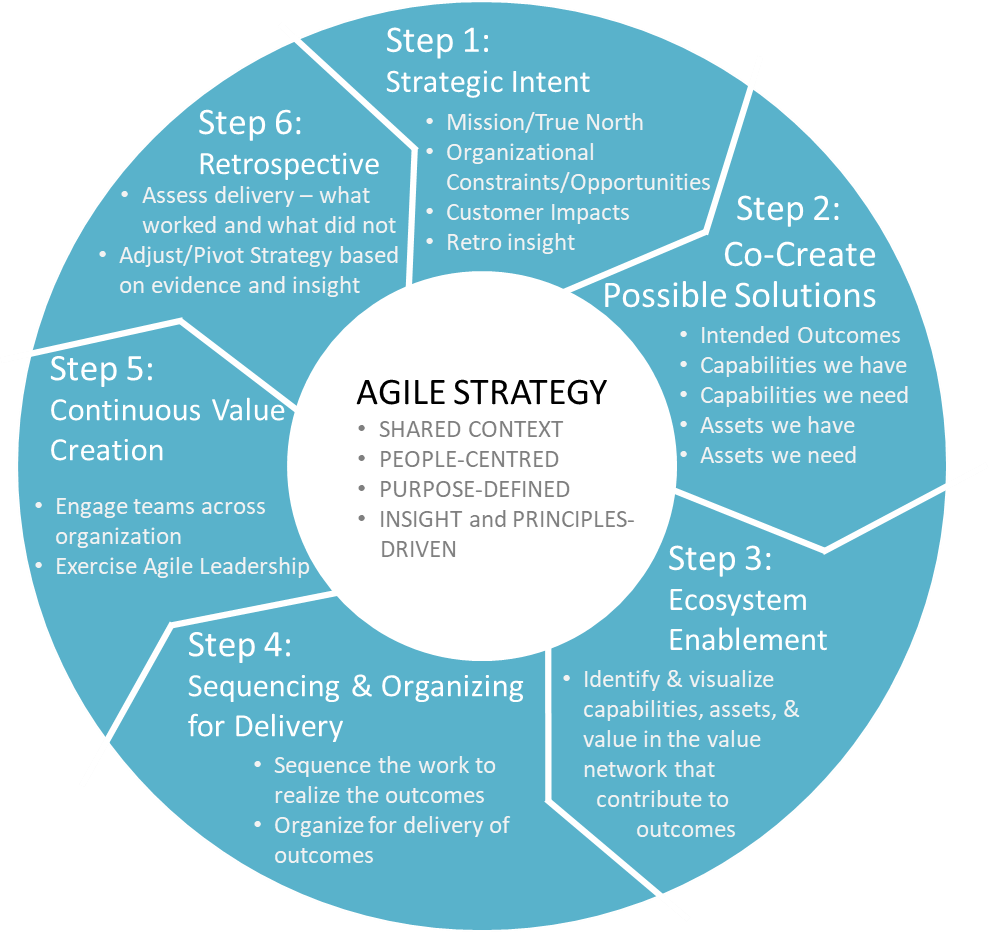 There are six steps to the process, which we’ll examine in detail in the next sections:
There are six steps to the process, which we’ll examine in detail in the next sections:
It’s important to note, however, that these steps don’t represent a sequential, one-pass process. Instead, participants will continually revisit earlier steps as the later steps inform their understanding.
Key tenets of agile strategy are that organizational strategy must be:
The first pass through Steps 1 to 4 should typically be complete within ten days.
Strategic intent is the direction-setting stage of the process. It’s about setting a course for the future: where the organization is aiming to go and why.
An important element, which distinguishes this step from goal-setting in traditional strategic planning, is to recognize that the organization’s strategic intent is simply a theory of planned change. Like any theory, it can only be validated through execution. To test our current strategic intent theory, we need act according to the intent and gather evidence along the way, so we can then either carry on in the same direction, adjust our next set of actions, or adjust our theory, aka pivot our strategy.
There are four parts to establishing strategic intent:
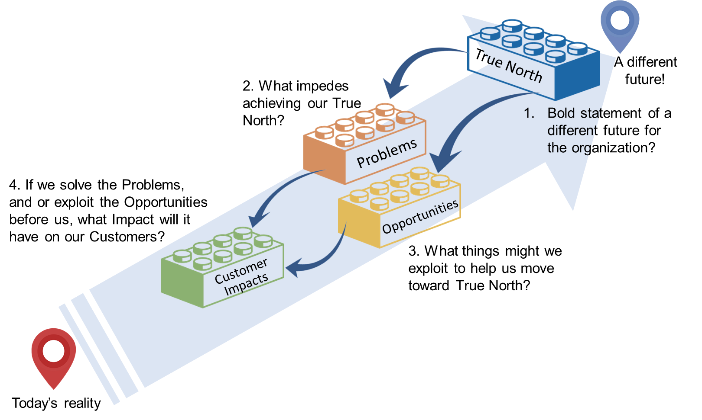
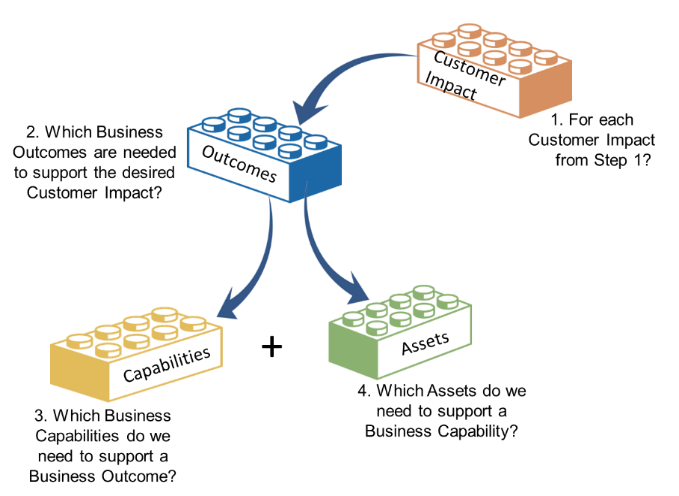 In the second step of our strategic discovery process, we explore what possible solutions might look like. We say “might” because organizations can never be entirely sure whether proposed solutions will work, or are complete, until they start implementing them.
In the second step of our strategic discovery process, we explore what possible solutions might look like. We say “might” because organizations can never be entirely sure whether proposed solutions will work, or are complete, until they start implementing them.
For this reason, delivering the proposed solutions to the customer – and working with everyone necessary within the organization and in partner organizations to do so – isn’t the end result of the agile planning process. Rather, it represents the experimentation part of the feeback loop, informing future iterations of the solutions.
In this step, planners should look at each customer impact identified in Step 1 and break down the what is needed to achieve it. This involves a two-fold analysis:
| Capabilities | Assets |
|---|---|
| A business capability describes an organization’s ability to perform what’s necessary to achieve a purpose-defined business outcome in support of impacts desired by the clients/customers/citizens. Impacts are the tangible and intangible results of having solved problems or exploited opportunities. Capabilities are created when people combine competencies with tools and systems, processes and organizational structures, to do something or deliver something that is considered to be of value to someone – a client/customer/citizen, our own organization, or a partner organization. | Assets can include, but are not limited to,
|
Many organizations fail to include all these asset types when discussing solutions, as technology assets tend to be the default focus. This oversight is one of several leading causes of large project failures.
In the first 90-day cycle, we do enough in this step to get started on validating parts of the proposed solutions. In the subsequent 90-day cycles, we’ll adjust, based on what’s learned during implementation/experimentation.
 Most organizations don’t have all the capabilities and assets in-house that are necessary to realize all their business outcomes. Particularly in the very dynamic and networked world in which we live, leveraging partnerships is key to success for most organizations. Therefore, Step 3 focuses on the business ecosystem necessary for the organization to achieve its strategic intent.
Most organizations don’t have all the capabilities and assets in-house that are necessary to realize all their business outcomes. Particularly in the very dynamic and networked world in which we live, leveraging partnerships is key to success for most organizations. Therefore, Step 3 focuses on the business ecosystem necessary for the organization to achieve its strategic intent.
In this step, we explore which business capabilities and associated assets ought to be handled internally and which ones may be better fulfilled by partners within the larger business ecosystem. In some cases, a certain business capability and its associated assets will be supplied either entirely internally or entirely by a partner. However, in many cases, the picture may be more complex, with a combination of both scenarios for a single business capability.
Steps 1 to 3 can typically be completed in three to five days, taking up the bulk of the first week of the 90-day cycle. As the leaders and their teams complete each step, they may uncover a need to adjust their ideas from a previous step. This is normal and is why we say these steps should not be viewed as a sequential, one-pass process. It’s more about how we structure our conversations and idea-generating around why we need to do something different, why now, and what that might mean.
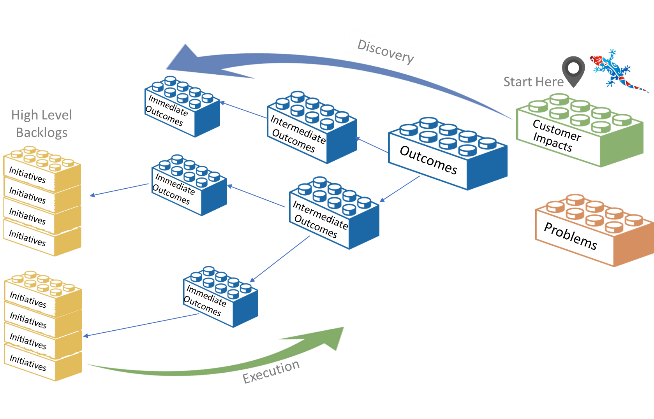 By the end of the first week, we will have established our strategic intent, captured what might work as part of the possible solutions, and discovered some details of key ecosystem partners who will be needed.
By the end of the first week, we will have established our strategic intent, captured what might work as part of the possible solutions, and discovered some details of key ecosystem partners who will be needed.
Its important to understand the difference between priorities and sequencing. Priority setting is a top-down list of the order of activities While sequencing arranges activities in a logical order of pre and co-requisite activities.
During the second week, the focus is on sequencing and organizing the work to be done in the next nine weeks (weeks 3-11 of the 90-day cycle). The teams determine what needs to be done – their work backlogs – and in what order, as well as how to incrementally build out the required business capabilities and assets.
To do this, they must:
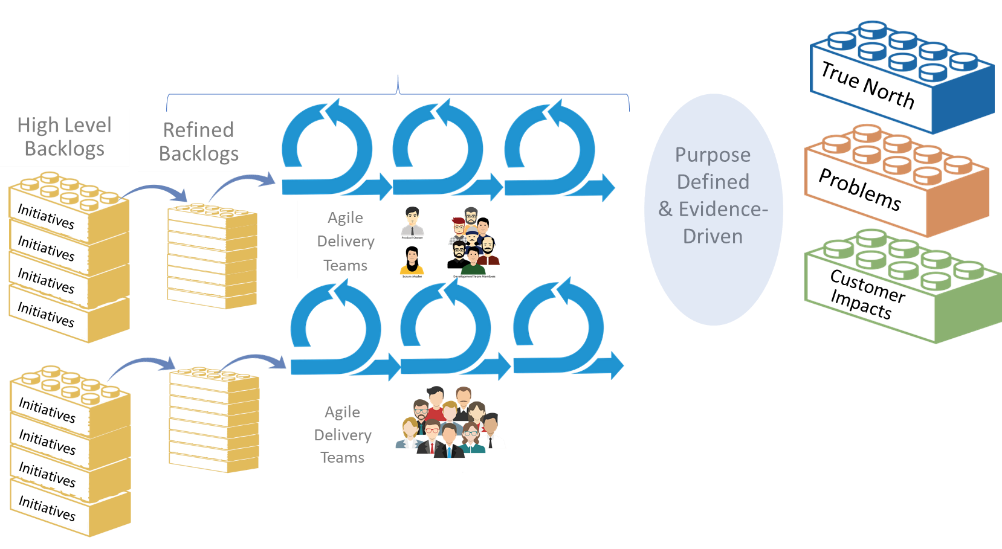 In Step 5, the bulk of the 90-day cycle, the teams will actually work on the initiatives and backlogs defined in Step 4. However, first, each team must develop a more refined version of the backlog(s) developed for their initiatives. This usually takes the first few days of Week 3.
In Step 5, the bulk of the 90-day cycle, the teams will actually work on the initiatives and backlogs defined in Step 4. However, first, each team must develop a more refined version of the backlog(s) developed for their initiatives. This usually takes the first few days of Week 3.
Assuming teams are using Agile or Lean execution approaches – such as Scrum, SAFe, LeSS, Scrum@Scale, Kanban, DAD, etc. – the level of refinement in each backlog only needs to look ahead as far as that team’s iteration cadence has been set to, be it one, two or four weeks. We recommend the shortest cadence the teams can reasonably accommodate.
We call this step Continuous Value Creation, as the goal for any organization that wishes to be adaptive and agile is to deliver value early and often, including many times per day if possible. This would mirror vanguard companies like Google and Shopify.
Step 5 is also where leaders get to practice their new roles as culture and context curators, rather than top-down governors. It will be important for them to leave the detailed decisions on what, how, and when to their teams. Their biggest contribution during weeks 3-15 will be to exhibit empathy to their teams as they master these new ways of working and to be responsive to team requests for help in removing impediments or obstacles.
Some people will struggle with these new ways of working, and it is up to leaders to create a psychologically safe environment – the only way to enable the radical transparency that’s utterly necessary to successful evidence-gathering during this phase. This can make or break the success of the whole process.
Whereas in traditional organizations no one truly has a view into all aspects of what is going on at any given moment or why – and, worse, information is often sanitized in both directions between the executives and their teams – the sharing of complete and accurate information is crucial for agile strategy to work. Thus, leaders must both practice radical transparency themselves and create a safe space for teams to be radically transparent as well, a key outcome of practicing empathy.
During this phase, the delivery teams are responsible for the daily escalation of issues that can’t be resolved at the team level. They are also responsible for conducting retrospectives on their work at regular intervals and re-planning what they need to do in the next iteration.
It is recommended to review overall progress at days 30 and 60 within each 90-day cycle, to assess overall progress toward the intermediate outcomes and to get a pulse on any constraints or risks that may be tied to the old ways of doing things. These interim touchpoints will also provide some insight into what to consider in Step 6.
 Step 6 is about gathering the collective insights of all those who have participated in the work so far. This involves asking a series of probing questions that includes, but is not limited to:
Step 6 is about gathering the collective insights of all those who have participated in the work so far. This involves asking a series of probing questions that includes, but is not limited to:
While Steps 1 to 5 are about purpose-defined action, Step 6 is about using evidence and collective insights to adjust what we do next, as opposed to simply following a strategy based on how it was originally constructed.
Most organizations experience a gap between strategy and execution that directly results from inadequate transparency, which hampers their ability to accurately assess their performance and plans. When they can consistently evaluate performance based on accurate information, they ensure their strategies reflect the evidence and their collective insights, so they can continuously make the adjust-or-pivot decisions necessary to be resilient and sustainable over the long run.
Becoming resilient and sustainable – able to not only survive through turbulent change but to thrive as well – is the mark of a truly adaptive and agile organization.
After the first 90-day cycle, we repeat the process, continually cycling through these steps to maintain the health and agility of the organization. However, the time allocated to each step will vary.
When an organization sees no need to pivot strategy, Step 5 – implementation/experimentation – will comprise about 95% of the time in the next 90-day cycle. Nevertheless, it’s still critically important to engage in abbreviated versions of Steps 1-4 and Step 6 in each cycle, so as to make needed adjustments based on the evidence and insights gleaned during the previous cycle.
If a full pivot in strategy is needed, on the other hand, Steps 1-4 will require just as much time as in the first pass.
And of course, throughout all cycles, leaders and teams should continually revisit and remain focused on shared context and values and principles. Establishing and maintaining a shared context is a prerequisite for action and decision-making, while organization-wide values and principles should guide everyone’s behaviors, actions, and decision-making.
What makes and organization successful?
The drastically accelerating rate of change caused by the recent pandemic has exposed systemic weaknesses in organizations across the private, public, and third sectors, including those who previously seemed to manage externally-driven change reasonably well.
However, rapidly evolving circumstances have also highlighted leaders’ and teams’ capacity to think and act differently, as demonstrated in many organizations’ abilities to temporarily cast aside restrictive policies to adjust and pivot their approaches during times of crisis.
Lasting success for any organization will depend upon its ability to leverage this capacity to think and act differently during crisis into a long-term ability to consistently adapt to changing circumstances. When change is the new normal, building agility into the very fiber of our organizations is the key to surviving it.
Please subscribe and become a member to access the entire Business Agility Library without restriction.